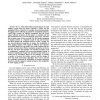Free Online Productivity Tools
i2Speak
i2Symbol
i2OCR
iTex2Img
iWeb2Print
iWeb2Shot
i2Type
iPdf2Split
iPdf2Merge
i2Bopomofo
i2Arabic
i2Style
i2Image
i2PDF
iLatex2Rtf
Sci2ools
103
click to vote
SOCIALCOM
2010
2010
On the Navigability of Social Tagging Systems
It is a widely held belief among designers of social tagging systems that tag clouds represent a useful tool for navigation. This is evident in, for example, the increasing number of tagging systems offering tag clouds for navigational purposes, which hints towards an implicit assumption that tag clouds support efficient navigation. In this paper, we examine and test this assumption from a network-theoretic perspective, and show that in many cases it does not hold. We first model navigation in tagging systems as a bipartite graph of tags and resources and then simulate the navigation process in such a graph. We use network-theoretic properties to analyse the navigability of three tagging datasets with regard to different user interface restrictions imposed by tag clouds. Our results confirm that tagresource networks have efficient navigation properties in theory, but they also show that popular user interface decisions (such as "pagination" combined with reverse-chronological...
Related Content
| Added | 15 Feb 2011 |
| Updated | 15 Feb 2011 |
| Type | Journal |
| Year | 2010 |
| Where | SOCIALCOM |
| Authors | Denis Helic, Christoph Trattner, Markus Strohmaier, Keith Andrews |
Comments (0)

